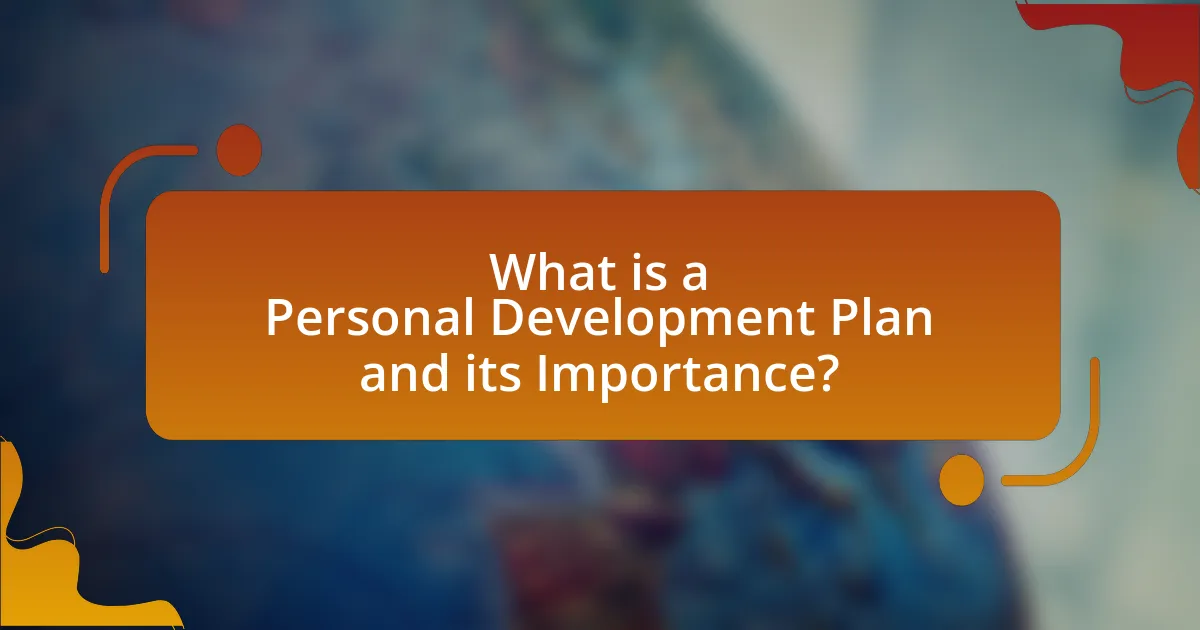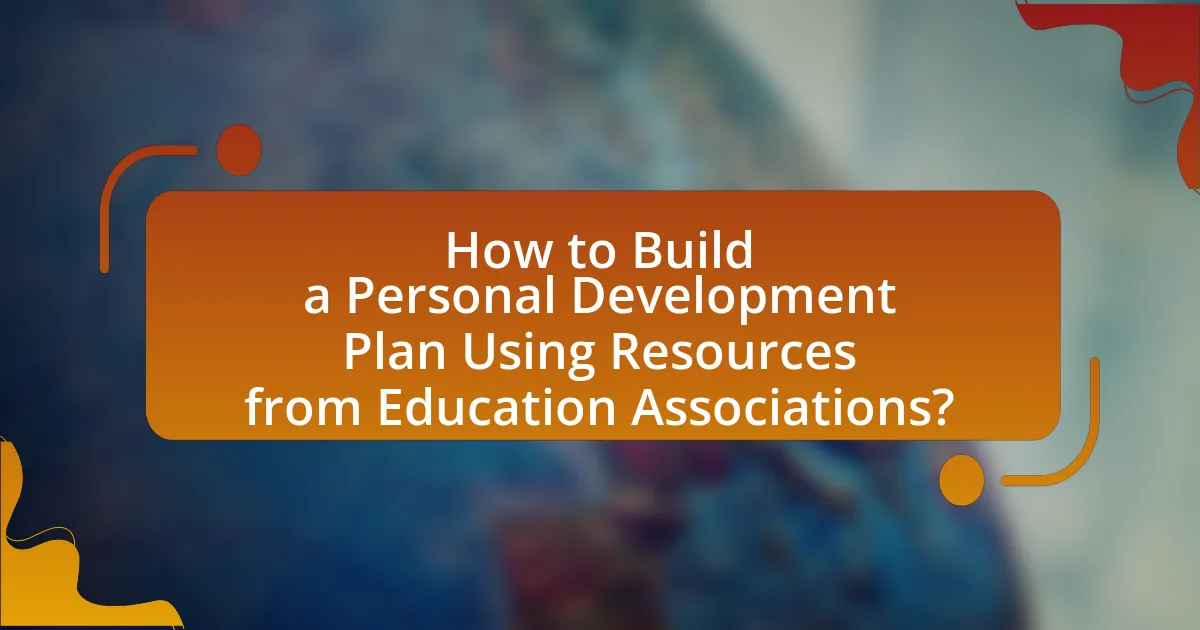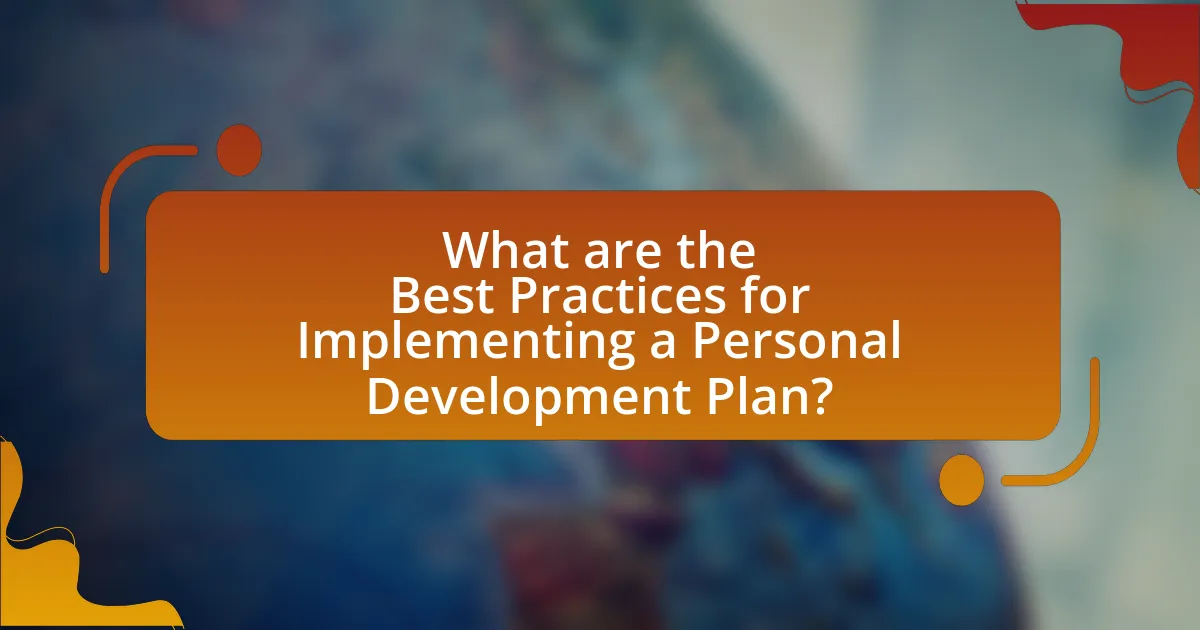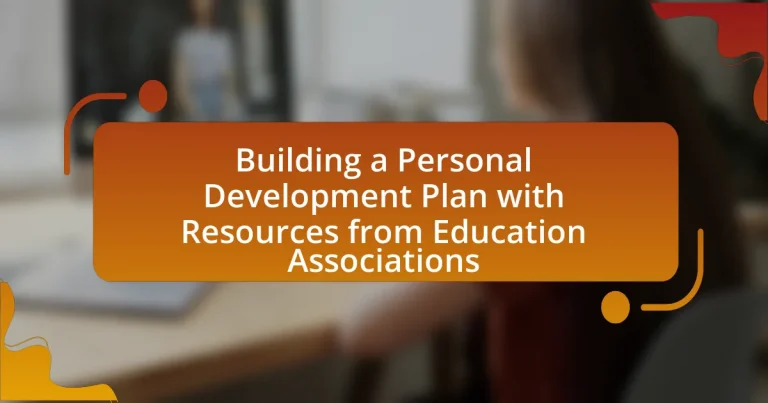A Personal Development Plan (PDP) is a structured framework that helps individuals set and achieve personal and professional goals, enhancing self-awareness and accountability. This article explores the significance of a PDP in fostering individual growth, detailing its key elements such as goal-setting, self-assessment, and action steps. It also highlights the role of education associations in providing resources and support for creating effective PDPs, including professional development workshops and networking opportunities. Additionally, the article outlines best practices for implementing a PDP, monitoring progress, and overcoming common challenges, ensuring a comprehensive understanding of how to leverage educational resources for personal development.

What is a Personal Development Plan and its Importance?
A Personal Development Plan (PDP) is a structured framework that individuals use to set personal and professional goals, identify the skills and knowledge needed to achieve those goals, and outline the steps required to reach them. The importance of a PDP lies in its ability to provide clarity and direction, enabling individuals to take proactive steps toward self-improvement and career advancement. Research indicates that individuals with a clear PDP are more likely to achieve their objectives, as it fosters accountability and encourages continuous learning and development.
How does a Personal Development Plan contribute to individual growth?
A Personal Development Plan (PDP) significantly contributes to individual growth by providing a structured framework for setting and achieving personal and professional goals. This framework encourages self-reflection, enabling individuals to identify their strengths, weaknesses, and areas for improvement. Research indicates that individuals who engage in structured planning, such as through a PDP, are more likely to achieve their goals, as they can track progress and adjust strategies accordingly. For instance, a study published in the Journal of Applied Psychology found that goal-setting and self-monitoring are key factors in enhancing performance and motivation, demonstrating the effectiveness of a PDP in fostering individual growth.
What are the key elements of an effective Personal Development Plan?
An effective Personal Development Plan (PDP) includes clear goals, self-assessment, action steps, and a timeline for evaluation. Clear goals provide direction and focus, ensuring that individuals know what they aim to achieve. Self-assessment allows individuals to understand their strengths and weaknesses, which is crucial for setting realistic and achievable goals. Action steps outline the specific activities and resources needed to reach these goals, while a timeline for evaluation helps track progress and make necessary adjustments. Research indicates that structured plans significantly enhance personal growth and achievement, as evidenced by studies showing that individuals with defined goals are more likely to succeed in their personal and professional endeavors.
Why is self-assessment crucial in creating a Personal Development Plan?
Self-assessment is crucial in creating a Personal Development Plan because it enables individuals to identify their strengths, weaknesses, and areas for improvement. This reflective process allows individuals to set realistic and achievable goals tailored to their unique circumstances. Research indicates that self-assessment enhances self-awareness, which is essential for effective personal growth; a study published in the Journal of Educational Psychology found that students who engaged in self-assessment demonstrated higher academic performance and motivation. By understanding their current skills and knowledge, individuals can create a more focused and effective Personal Development Plan that aligns with their aspirations and needs.
What role do education associations play in personal development?
Education associations play a crucial role in personal development by providing resources, networking opportunities, and professional development programs. These associations offer access to workshops, conferences, and training sessions that enhance skills and knowledge relevant to various educational fields. For instance, the National Education Association (NEA) provides resources that help educators improve their teaching practices, which directly contributes to their personal and professional growth. Additionally, education associations facilitate connections among professionals, allowing for the exchange of ideas and best practices, further enriching personal development.
How can education associations provide resources for personal development?
Education associations can provide resources for personal development by offering professional development workshops, online courses, and access to mentorship programs. These associations often curate a variety of educational materials and training sessions tailored to enhance skills and knowledge in specific fields. For instance, the National Education Association (NEA) provides resources such as webinars and conferences that focus on best practices in teaching and leadership development. Additionally, many associations maintain online platforms where members can access articles, research, and tools that support continuous learning and personal growth.
What types of support do education associations offer for creating a Personal Development Plan?
Education associations offer various types of support for creating a Personal Development Plan (PDP), including professional development workshops, access to resources and templates, mentorship programs, and networking opportunities. These associations often conduct workshops that provide educators with the skills and knowledge necessary to develop effective PDPs, ensuring that they align with professional standards and personal goals. Additionally, many associations provide templates and guidelines that simplify the PDP creation process, making it easier for educators to structure their plans. Mentorship programs connect less experienced educators with seasoned professionals who can offer personalized advice and feedback on PDPs. Furthermore, networking opportunities allow educators to share best practices and learn from peers, enhancing the overall effectiveness of their personal development efforts.

How to Build a Personal Development Plan Using Resources from Education Associations?
To build a personal development plan using resources from education associations, individuals should first identify their specific goals and areas for improvement. Education associations often provide a wealth of resources, including professional development workshops, online courses, and networking opportunities that can be tailored to these goals. For example, the National Education Association offers various professional learning resources that educators can utilize to enhance their skills. By leveraging these resources, individuals can create a structured plan that outlines their objectives, the resources they will use, and a timeline for achieving their goals. This approach ensures that the personal development plan is both actionable and aligned with the support available through education associations.
What steps should be taken to create a Personal Development Plan?
To create a Personal Development Plan, individuals should follow these steps: first, assess current skills and identify areas for improvement. This involves self-reflection and possibly seeking feedback from peers or mentors. Next, set specific, measurable, achievable, relevant, and time-bound (SMART) goals that align with personal and professional aspirations. After establishing goals, outline actionable steps to achieve them, including resources needed and potential obstacles. Finally, regularly review and adjust the plan to reflect progress and changing circumstances, ensuring continuous development. This structured approach is supported by educational frameworks that emphasize goal-setting and self-assessment as key components of effective personal development.
How can one identify personal goals and objectives?
To identify personal goals and objectives, one should engage in self-reflection to assess values, interests, and strengths. This process involves asking oneself critical questions about what is truly important and what aspirations one has for the future. Research indicates that individuals who utilize structured frameworks, such as SMART criteria (Specific, Measurable, Achievable, Relevant, Time-bound), are more effective in setting clear and actionable goals. A study published in the Journal of Applied Psychology found that goal-setting significantly enhances performance and motivation, demonstrating the importance of clarity in personal objectives.
What resources from education associations can assist in goal setting?
Education associations provide various resources to assist in goal setting, including professional development workshops, online courses, and goal-setting frameworks. For instance, the National Education Association (NEA) offers workshops that focus on setting measurable and achievable goals for educators, which can enhance teaching effectiveness. Additionally, the Association for Supervision and Curriculum Development (ASCD) provides online courses that guide educators in creating personal development plans aligned with their professional goals. These resources are designed to help educators establish clear objectives, track progress, and ultimately improve educational outcomes.
How can education associations enhance the effectiveness of a Personal Development Plan?
Education associations can enhance the effectiveness of a Personal Development Plan (PDP) by providing structured resources, professional development opportunities, and networking platforms. These associations often offer workshops, seminars, and online courses that equip individuals with the necessary skills and knowledge to achieve their personal and professional goals. For instance, the American Educational Research Association provides access to research and best practices that can inform and improve PDP strategies. Additionally, education associations facilitate connections among members, allowing for mentorship and collaboration, which can lead to more tailored and effective personal development strategies.
What tools and frameworks do education associations provide for planning?
Education associations provide various tools and frameworks for planning, including strategic planning templates, professional development frameworks, and assessment tools. These resources help educators and institutions align their goals, evaluate progress, and implement effective teaching strategies. For example, the National Education Association offers a comprehensive strategic planning guide that outlines steps for creating actionable plans, while the Association for Supervision and Curriculum Development provides frameworks for curriculum development and instructional improvement. These tools are designed to enhance educational outcomes and support continuous improvement in teaching practices.
How can networking with education associations support personal development?
Networking with education associations can significantly enhance personal development by providing access to a wealth of resources, mentorship opportunities, and professional connections. Engaging with these associations allows individuals to gain insights into best practices, emerging trends, and innovative strategies in education, which can inform their personal growth and career advancement. For instance, research by the National Education Association indicates that members who actively participate in networking events report higher levels of job satisfaction and professional efficacy. This demonstrates that networking not only fosters relationships but also contributes to a deeper understanding of the educational landscape, ultimately supporting personal development.

What are the Best Practices for Implementing a Personal Development Plan?
The best practices for implementing a personal development plan include setting clear, specific goals, regularly reviewing progress, and seeking feedback from mentors or peers. Clear goals provide direction and motivation, while regular reviews allow for adjustments based on progress and changing circumstances. Seeking feedback enhances accountability and offers new perspectives, which can lead to improved strategies and outcomes. Research indicates that individuals who set specific goals are more likely to achieve them, as evidenced by a study published in the American Journal of Lifestyle Medicine, which found that goal-setting significantly increases the likelihood of success in personal development initiatives.
How can one effectively monitor progress in a Personal Development Plan?
To effectively monitor progress in a Personal Development Plan, one should establish specific, measurable goals and regularly review them. This involves setting clear benchmarks for each goal, utilizing tools such as journals or digital tracking apps to document progress, and scheduling periodic evaluations to assess achievements and areas needing improvement. Research indicates that individuals who engage in regular self-assessment and reflection are more likely to achieve their developmental objectives, as highlighted in a study by Zimmerman and Kitsantas (2005) in the Journal of Educational Psychology, which emphasizes the importance of self-regulated learning in personal development.
What metrics can be used to evaluate success in personal development?
Metrics that can be used to evaluate success in personal development include goal achievement, self-assessment scores, feedback from peers or mentors, and behavioral changes. Goal achievement measures the extent to which individuals meet specific, predefined objectives, providing a clear indicator of progress. Self-assessment scores, often derived from standardized tools or reflective practices, allow individuals to gauge their skills and competencies over time. Feedback from peers or mentors offers external perspectives on growth and areas for improvement, enhancing the evaluation process. Behavioral changes, observable in daily actions and decisions, reflect the practical application of personal development efforts. These metrics collectively provide a comprehensive framework for assessing personal development success.
How often should one review and update their Personal Development Plan?
One should review and update their Personal Development Plan at least once every six months. Regular reviews ensure that the plan remains relevant and aligned with personal goals and changing circumstances. Research indicates that individuals who engage in consistent self-reflection and adjustment of their development plans are more likely to achieve their objectives, as they can adapt to new opportunities and challenges effectively.
What common challenges might arise when building a Personal Development Plan?
Common challenges that arise when building a Personal Development Plan include lack of clarity in goals, insufficient self-awareness, and difficulty in maintaining motivation. Lack of clarity can lead to vague objectives, making it hard to measure progress. Insufficient self-awareness may result in unrealistic expectations or overlooking areas needing improvement. Difficulty in maintaining motivation often stems from setting overly ambitious goals or not having a support system in place. Research indicates that 70% of individuals fail to achieve their personal development goals due to these challenges, highlighting the importance of addressing them effectively.
How can one overcome obstacles in the planning process?
One can overcome obstacles in the planning process by employing strategic problem-solving techniques. Identifying specific challenges, such as resource limitations or time constraints, allows for targeted solutions. For instance, utilizing tools like SWOT analysis (Strengths, Weaknesses, Opportunities, Threats) can clarify the situation and guide decision-making. Research indicates that organizations that implement structured planning frameworks, such as the Project Management Institute’s PMBOK Guide, experience a 20-30% increase in project success rates. This demonstrates that systematic approaches to planning can effectively mitigate obstacles and enhance overall outcomes.
What strategies can be employed to stay motivated throughout the journey?
To stay motivated throughout the journey of building a personal development plan, individuals can employ strategies such as setting specific, measurable goals, maintaining a positive mindset, and seeking accountability through support networks. Setting clear goals provides direction and a sense of purpose, which is essential for motivation; research indicates that individuals who set specific goals are more likely to achieve them (Locke & Latham, 2002). Maintaining a positive mindset helps to overcome challenges and fosters resilience, as studies show that optimism can enhance performance and persistence (Seligman, 1990). Additionally, engaging with support networks, such as mentors or peer groups, creates accountability and encouragement, which are critical for sustaining motivation over time.
What practical tips can enhance the creation of a Personal Development Plan?
To enhance the creation of a Personal Development Plan, individuals should set specific, measurable, achievable, relevant, and time-bound (SMART) goals. This framework ensures clarity and focus, making it easier to track progress and adjust plans as necessary. Research indicates that individuals who set SMART goals are 30% more likely to achieve their objectives compared to those who do not use this method. Additionally, regularly reviewing and updating the plan fosters accountability and motivation, which are crucial for sustained personal growth.


